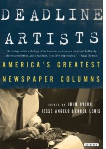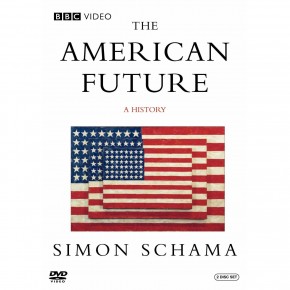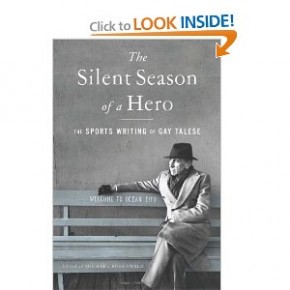Deadline Artists: America’s Greatest Newspaper Columns

Edited by John Avlon, Jesse Angelo & Errol Louis
At a time of great transition in the news media, Deadline Artists celebrates the relevance of the newspaper column through the simple power of excellent writing. It is an inspiration for a new generation of writers—whether their medium is print or digital-looking to learn from the best of their predecessors.
This new book features two of Mike’s columns from The Boston Globe. The book says, “Barnicle is to Boston what Royko was to Chicago and Breslin is to New York—an authentic voice who comes to symbolize a great city. Almost a generation younger than Breslin & Co., Barnicle also serves as the keeper of the flame of the reported column. A speechwriter after college, Barnicle’s column with The Boston Globe ran from 1973 to 1998. He has subsequently written for the New York Daily News and the Boston Herald, logging an estimated four thousand columns in the process. He is also a frequent guest on MSNBC’s Morning Joe as well as a featured interview in Ken Burns’s Baseball: The Tenth Inning documentary.”
Read the columns here (you can buy the book by clicking here)
“Steak Tips to Die For” – Boston Globe – November 7, 1995
Those who think red meat might be bad for you have a pretty good argument this morning in the form of five dead guys killed yesterday at the 99 Restaurant in Charlestown. It appears that that two late Luisis, Bobby, the father, and Roman, his son, along with their three pals, sure did love it because there was so much beef spread out in front of the five victims that their table-top resembled a cattle drive.
“All that was missing was the marinara,” a detective was saying yesterday. “If they had linguini and marinara it would have been like that scene in The Godfather where Michael Corleone shoots the Mafia guy and the cop. But it was steak tips.”
Prior to stopping for a quick bite, Roman Luisi was on kind of a roll. According to police, he recently beat a double-murder charge in California. Where else?
But that was then and this is now. And Sunday night, he got in a fight in the North End. Supposedly, one of those he fought with was Damian Clemente, 20 years old and built like a steamer trunk. Clemente, quite capable of holding a grudge, is reliably reported to have sat on Luisi.
Plus, it is now alleged that at lunch yesterday, young Clemente, along with Vincent Perez, 27, walked into the crowded restaurant and began firing at five guys in between salads and entrée. The 99 is a popular establishment located at the edge of Charlestown, a section of the city often pointed to as a place where nearly everyone acts like Marcel Marceau after murders take place in plain view of hundreds.
Therefore, most locals were quick to point out that all allegedly involved in the shooting—the five slumped on the floor as well as the two morons quickly captured outside—were from across the bridge. Both the alleged shooters and the five victims hung out in the North End.
However, yesterday, it appears, everyone was playing an away game. For those who still think “The Mob” is an example of a talented organization capable of skillfully executing its game plan, there can be only deep disappointment in the aftermath of such horrendous, noisy and public violence.
It took, oh, about 45 seconds for authorities to track down Clemente and Perez. Clemente is of such proportions that his foot speed is minimal. And it is thought that his partner Perez’s thinking capacity is even slower than Clemente’s feet.
Two Everett policeman out of uniform—Bob Hall and Paul Durant—were having lunch a few feet away from where both Luisis and the others were having the last supper. The two cops have less than five years’ experience combined but both came up huge.
“They didn’t try anything crazy inside. They didn’t panic,” another detective pointed out last night. “They followed the two shooters out the door, put them down and held them there. They were unbelievably level-headed, even when two Boston cops arrived and had their guns drawn on the Everett cops because they didn’t know who they were, both guys stayed cool and identified themselves. And they are going to make two truly outstanding witnesses.”
The two Boston policemen who arrived in the parking lot where Clemente and Perez were prone on the asphalt were Tom Hennessey and Stephen Green. They were working a paid detail nearby which, all things being equal, immediately led one official to cast the event in its proper, parochial perspective: “This ought to put an end to the argument to do away with paid details,” he said. “Hey, ask yourself this question: You think a flagman could have arrested these guys?”
The entire event—perhaps four minutes in duration, involving at least 13 shots, five victims and two suspects caught—is a bitter example of how downsizing has affected even organized crime. For several years, the federal government has enforced mandatory retirement rules—called jail—on several top local mob executives.
What’s left are clowns who arrive for a great matinee murder in a beat-up blue Cadillac and a white Chrysler that look like they are used for Bumper-Car. The shooters then proceed to leave a restaurant filled with the smell of cordite and about 37 people capable of picking them out of a lineup.
“Part of it was kind of like in the movies, but part of it wasn’t,” an eyewitness said last night. “The shooting part was like you see in a movie but the fat guy almost slipped and fell when he was getting away. That part you don’t see in a movie. But what a mess that table was.”
“We have a lot of evidence, witnesses and even a couple weapons,” a detective pointed out last evening. “But the way things are going in this country it would not surprise me if the defense argues that they guys were killed by cholesterol.”
“New Land, Sad Story” – Boston Globe – November 23, 1995
Three Cadillac hearses were parked on Hastings Street outside Calvary Baptist Church in Lowell Tuesday morning as an old town wrestled with new grief. Inside, the caskets had been placed together by the altar while the mother of the dead boys, a Cambodian woman named Chhong Yim, wept so much it seemed she cried for a whole city.
The funeral occurred two days before the best of American holidays and revolved around a people, many of whom have felt on occasion that God is symbolized by stars, stripes and the freedom to walk without fear. But a bitter truth was being buried here as well because now every Cambodian man, woman and child knows that despite fleeing the Khmer Rouge and soldiers who killed on whim, nobody can run forever from a plague that is as much a bitter part of this young country as white meat and cranberry sauce.
The dead children were Visal Men, 15, along with his two brothers Virak, 14, and Sovanna, 9, born in the U.S.A. They were shot and stabbed last week when the mother’s friend, Vuthy Seng, allegedly became enraged at being spurned by Chhong Yim, who chose her children over Seng.
There sure are enough sad stories to go around on any given day. However, there aren’t many to equal the slow demise of a proud, gentle culture—Cambodian—as it is bastardized by the clutter and chaos we not only allow to occur but willingly accept as a cost of democracy.
The three boys died slowly; first one, then the other in a hospital and, finally, the third a few days after Seng supposedly had charged into the apartment with a gun and a machete. He shot and hacked all three children along with their sister, Sathy Men, who is 13 and stood bewildered beside her howling mother, the two of them survivors of a horror so deep their lives are forever maligned.
At 10:45, as the funeral was set to begin, two cops on motorcycles came up Hastings ahead of a bus filled with children from Butler Middle School. The boys and girls walked in silence into the chapel to pray for the dead who have left a firm imprint on their adopted hometown.
The crowd of mourners was thrilling in its diversity. There were policemen, firefighters, teachers and shopkeepers. The young knelt shoulder-to-shoulder with the old. There were Catholic nuns and Buddhist priests. There were friends of the family as well as total strangers summoned only by tragedy.
A little after 11 a.m., Hak Sen, who drove from Rhode Island, parked his car by the post office and headed toward Calvary Baptist Church.
“I am late. I got lost,” Hak Sen said.
“Are you a friend of the family?” he was asked.
“No,” he replied. “I do not know them. I come out of respect and sadness. We all make a terrible journey to come here to America and this is very, very bad.”
Hak Sen said he and his family were from Battambang Province, along the Thai-Cambodian border. He said that he served in the army before Pol Pot took over his country and that he and his family were forced to flee but not all made it to the refugee camps.
“I am lucky man,” Hak Sen pointed out. “I survive. My wife, she survive and two of our children, they survive.”
“Did you lose any children?” he was asked.
“Yes,” he said. “I lost three boys, just like this woman. Three boys and our daughter. They all dead. The malaria killed them in the jungle. There was not enough food and no water and they were young and could not fight the disease and they died. They all dead. My mother and father too.”
The innocent children inside the church as well as the big-hearted citizens of Lowell along with the majority of people who will buy a paper or carve a turkey today simply have no idea of the epic, tragic struggle of the Cambodians. They left a country where they were killed for owning a ballpoint pen or wearing a pair of eyeglasses to arrive in this country where, each day, we become more and more narcoticized by the scale of violence around us.
At the conclusion of the service, Lowell detectives Mike Durkin, John Boutselis and Phil Conroy helped carry the caskets to the hearses. The procession wound slowly through city streets, pausing for a few seconds outside the Butler School, where pupils lined both sides of the road like grieving sentries as the entourage entered Westlawn Cemetery.
“This is as sad as it gets,” said Roger LaPointe, a cemetery worker. “We cut the first two graves the end of last week but the funeral director told us we better hold on. When the third boy died, we had to cut it some more. It’s an awful thing. That hole just kept getting bigger.”






